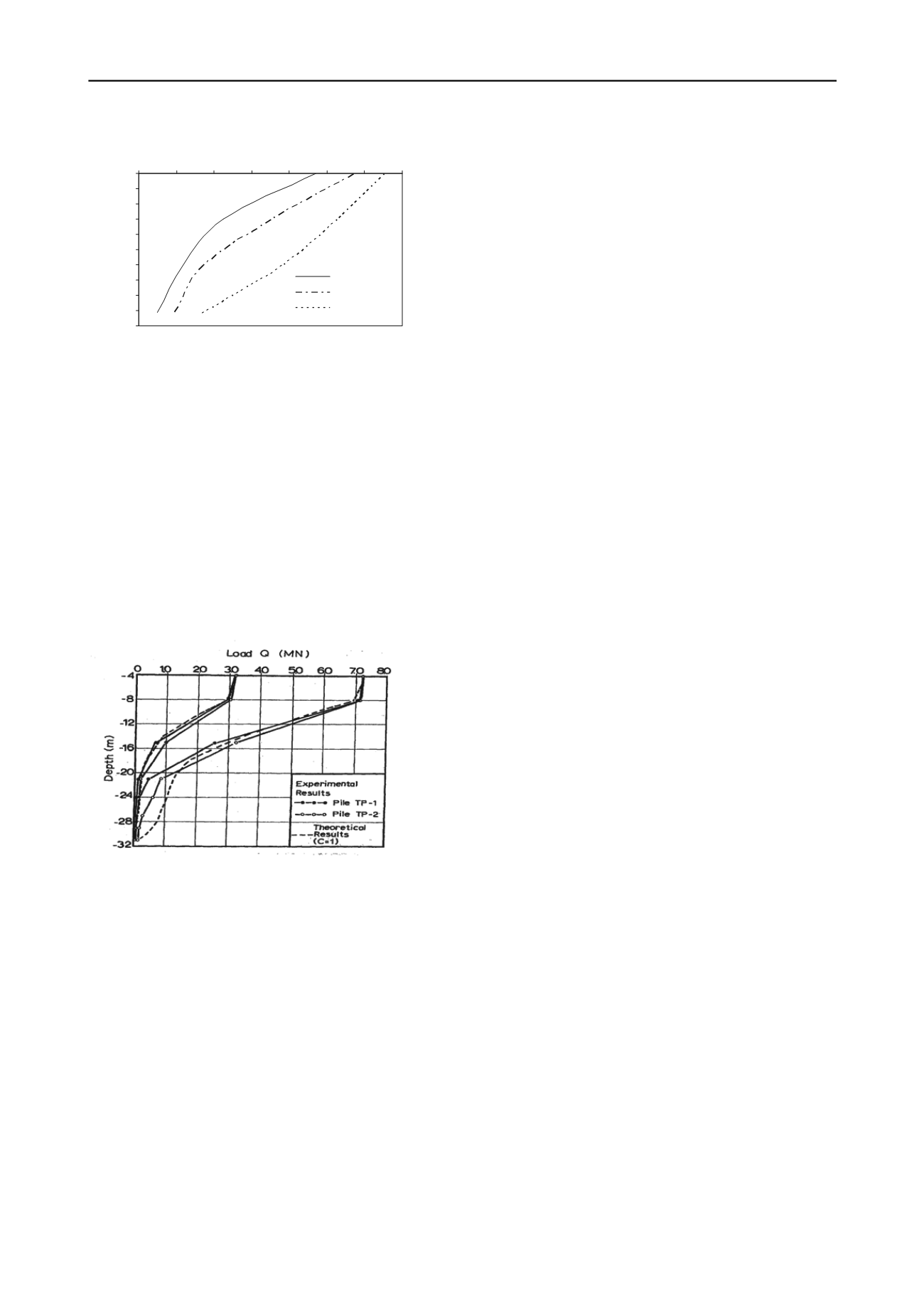
2674
Proceedings of the 18
th
International Conference on Soil Mechanics and Geotechnical Engineering, Paris 2013
0.00
0.11
0.22
0.33
0.44
0.55
0.66
0.77
0.88
0.99
1.10
0.00 0.40 0.80 1.20 1.60 2.00 2.40 2.80
SHAFT STRESS, N/mm
2
LENGTH RATIO
1
Central pile
Inner pile
Outer pile
Figure 7. Variation of stress along the shaft of
typical piles along the centre line of raft for 8.10kN
This establishes the fact that if the pile group of piled raft
can be idealised as a single large pier,then the procedure
adopted by Frank et al(1991) can be used to predict the
behaviour of pile group of piled raft foundations. Poulos (2001)
has shown that while studying the settlement behaviour of the
pile group, that if the pile group with the soil prism can be
considered as a single pier, then the procedure applied for a
single pile behaviour can be used for the prediction of the load
settlement response of the equivalent pier numerically using
axisymmetric analyses.The equivalent pier modulus E
eq
is given
by the expression
EEQ = E
S
+ (E
P
- E
S
) A
T
/A
G
(1)
The value of the Es can be the pressuremeter modulu,E
p
is the
pile material modulus, A
t
is the total cross sectional area of the
piles and A
g
is the gross plan area of the group. The equivalent
pier has the same plan area of the pile group and the length of
the pile can be taken as the length of the pier.The load
settlement response predicted by the pressuremeter with the
shaft friction mobilisation can be compared with the equivalent
pier analyses to validate the in-situ E
s
value over the length of
the pile (pile group) and the shaft friction over the length of the
pile group. This will also establish the shaft stress distribution at
any given settlement level and the in-situ E
s
value which can be
used in the detailed analyses.
9. CONCLUSIONS
The design economy in the piled raft design depends upon the
optimum design of the pile group of piled raft. Therefore before
the final design number of trials has to be made and also the
evaluation of in situ parameters has a considerable influence.
Keeping the above in mind the study carried out has shown that
the tri-linear relationship for the shaft friction mobilisation
adopted by Frank etal.,(1991 )to study the performance of two
single piles was in agreement with the trend of the characterised
load settlement response of the piled raft. Also the trend of shaft
friction mobilisation over the length of the pile agreed with the
prediction made from the pressuremeter test results in the case
of single pile. Based on the above it is concluded that the
equivalent pier theory can be used in combination with the
pressuremeter test results to predict the load settlement and load
sharing behaviour of the piled raft adopting parameters
determined from in-situ tests which are more reliable.
10. REFERENCES
Katzenbach R., Arslan V. and Moorman ch .2000a. Numerical
Stimulations of Combined Piled Raft Foundations for the New
High Rise Building, Max in Frankfurt am main, Proc. 2nd Int.
Conf. on Soil Structure Interaction in Urban Civil Engineering.
Poulos H.G. 2001. Piled Raft Foundation: Design and Application,
Geotechnique, 51( 2),111-113
Horikoshi K. 1995. Optimum Design of Piled Raft Foundations,
Dissertation submitted for the degree of Doctor of Philosophy,
University of Western Australia.
Polous H.G. 2008. The Piled Raft Foundation for the Burj Dubai –
Design & Performance. IGS – Ferroco Terzaghi, Oration – 2008.
Burland J.B. 1995. ‘Piles as Settlement Reducer’ 18th Italian Congress
on Soil Mech., Pavia.
Balakumar V. and Ilamparuthi K. 2007. Performance Monitoring of a
Piled Raft Foundation of Twelve Storied Building and Analytical
Validation, Indian geotechnical Journal, 37(2), 94-115.
Yamashita.K , Hamada.J, Yamada.T. 2010. Field Measurements On
Piled Rafts with Grid-Form Deep Mixing Walls on Soft Ground,
Geaotechnical Engineering-SEAGS .42(2) .
Cooke R.W. 1986. Piled Raft Foundation on Stiff Clays – A
Contribution to Design Philosophy, Geotechnique, 36(2),169 -203
Roger Franke, Nicholos Kateziotis , Michel Bustamante, Stavaros
Christoulos .1991. Evaluation of Performance of Two piles Using
Pressuremeter Methods - Journal of Geotechnical Engineering,
117(5), 695-713
Balakumar V., Kalaiarasi V. and Ilamparuthi K. 2005. Experimental and
Analytical Study on The Behaviour of Circular Piled Raft on Sand,
Proc. 16th Intl Conf. on Soil Mechanics and Geotechnical
Engineering-2005, Osaka, Japan, 1943-1947.
Figure 8. Comparison of Theoretical and Experimental Load
Distributions for Test Piles (Roger Frank et al.,) )1991)


